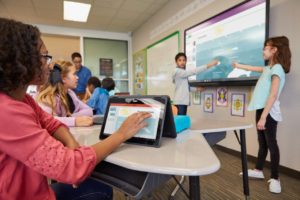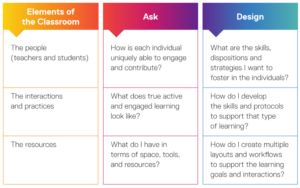It seems that no matter where we go today, we experience a world that is becoming increasingly connected through a network of enabling digital technologies, from our favorite grocery store to our workplace to our own homes. This same access to powerful, interactive digital technologies is continuing to grow for K-12 students―and with it, pedagogies for preparing students with the lifetime learning skills they’ll need to succeed.
Digital access to information and new tools for creation and collaboration bring new possibilities to the classroom. Teachers, freed from having to be the sole provider of both content and instruction, are eager to explore and implement new ways to help their students become more active participants in their own learning.

While active learning has become a mainstream concept in education, there is risk in taking a limited and fragmented approach to implementation. The tendency is to focus on things, whether that be digital tools, supplies, furniture, or physical space—and in turn, making decisions about each aspect in relative isolation from one another.
In contrast, we have seen much greater success when educators, administrators, and IT work together to focus first on outcomes; then determine the interactions and practices they want to enable; and then look at the range of resources available to help them do so (as shown in the framework below).
Designing for Active Learning

Leveraging synergies across digital and physical space
One advantage of this approach is that it leads to pedagogies and practices across digital and virtual learning spaces. For example, one teacher, wanting to shift from an ‘I teach’ to a ‘students learn’ dynamic, set up multiple writing surfaces around the classroom for students to mind-map, iterate, develop, and externalize their collaborative thinking. Rather than lose this information when surfaces were erased at the end of each period, students snapped digital images of their work. In addition to storing information for their referral and re-use, the teacher used the images to create a digital album for sharing learning beyond a single group or class to all classes who passed through that space.
Living ecosystems
One of the most rewarding aspects of my work has been to see well-designed learning ecosystems take on ‘a life of their own’ and evolve over time. Some examples include:
- A teacher, who set out to encourage students to teach each other, tells of the time she asked a student working with a fellow student to return to his seat because there was too much commotion in the room. Moments later, that student popped up as an avatar on the other student’s computer and the two picked up where they had left off.
- Another teacher had developed a robust project framework for student collaboration integrating digital tools and live group interactions to require active contribution by all team members. When one student was out of school for a week due to an injury, the student team, on their own, used the digital tools to collaborate remotely in real-time with the student and complete the project.
- An ESL teacher created mini-projects in 3D virtual space where students would have to use their English skills to work together to accomplish tasks. Soon students began creating their own scenarios, including a virtual scavenger hunt across multiple countries.
Just learn
The lesson for active learning might best be summed up by Danielle McRae, a teacher who posted this in her classroom:
Learn on what you want―on your laptop, on the wall, or on paper.
Learn where you want―on a chair, on the stools, or on the floor.
Learn with whom you want―in a group, with the teacher, by yourself.
JUST LEARN.